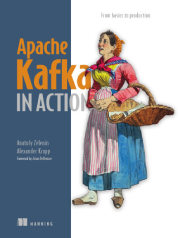
عنوان:
Apache Kafka in Action
نویسنده:
Anatoly Zelenin, Alexander Kropp
انتشارات:
Manning City: Shelter Island, NY
تاریخ انتشار:
2025
حجم:
4.6MB
معرفی کتاب:" Apache Kafka در عمل: از مبانی تا محیط تولید — چاپ اول "
اگر به دنبال درک عمیق و کاربردی از Apache Kafka هستید، این کتاب نقطهی آغاز بسیار مناسبی برای شماست. در "Apache Kafka in Action"، نویسندگان Anatoly Zelenin و Alexander Kropp ، با تکیه بر تجربهی عملی خود، مفاهیم Kafka را از پایه تا سطح تولید (production) آموزش میدهند.
ویژگیهای کلیدی:
- آموزش گامبهگام از مفاهیم پایه تا عملیات پیشرفته Kafka
- تمرکز بر ساخت اپلیکیشنهای دادهمحور مقاوم و مقیاسپذیر
- مثالهای واقعی و تصاویر گویا برای یادگیری آسانتر
- راهنمایی برای جلوگیری از خطاهای رایج و مدیریت عملکرد در محیط واقعی
آنچه در این کتاب میآموزید:
- نحوهی راهاندازی خوشههای Kafka و تولید/مصرف پیامها
- ادغام Kafka با معماریهای توزیعشده و زیرساختهای سازمانی
- پیادهسازی راهحلهای دادهمحور بلادرنگ (real-time)
- بهکارگیری Kafka در پایپلاینهای داده و اپلیکیشنهای event-driven
- نظارت، رفع اشکال، و حکمرانی مؤثر بر سیستم Kafka
Kafka چیست و چرا اهمیت دارد؟
Apache Kafka یک پلتفرم متنباز برای پردازش دادههای جریانی است که از مدل انتشار/اشتراک استفاده میکند. این فناوری به سازمانها امکان میدهد میلیونها رویداد در هر ثانیه را پردازش کنند و بهدلیل مقیاسپذیری بالا، تحملپذیری در برابر خطا، و طراحی توزیعشده، به استانداردی در حوزهی دادهمحور تبدیل شده است.
مخاطبان این کتاب:
مناسب برای توسعهدهندگان، مهندسان داده، معماران نرمافزار، و اپراتورهای IT است که با سیستمهای دادهی بلادرنگ کار میکنند یا قصد دارند Kafka را در پروژههای خود ادغام کنند—حتی بدون دانش قبلی از Kafka.
دربارهی نویسندگان:
- Anatoly Zelenin : متخصص Kafka و مربی بینالمللی، با سابقهی گسترده در صنعت بانکداری و تولید
- Alexander Kropp : متخصص Kafka و Kubernetes، فعال در طراحی و اجرای پلتفرمهای ابری
فهرست مطالب
- Apache Kafka in Action
- brief contents
- contents
- foreword
- preface
- acknowledgments
- about this book
- about the authors
- about the cover illustration
- Part 1 Getting started
- Chapter 1. Introduction to Apache Kafka
- 1.1 What is Apache Kafka, and how does it solve our problems?
- 1.2 Kafka in enterprise ecosystems
- 1.3 Architectural overview of Kafka
- 1.4 Running and using Kafka
- 1.5 Our learning path
- Chapter 2. First steps with Kafka
- 2.1 Introducing our use case
- 2.2 Producing messages
- 2.3 Consuming messages
- 2.4 Consuming and producing messages in parallel
- 2.5 Graphical user interfaces for Kafka
- Part 2 Concepts
- Chapter 3. Exploring Kafka topics and messages
- 3.1 Topics
- 3.2 Messages
- Chapter 4. Kafka as a distributed log
- 4.1 Logs
- 4.2 Kafka as a distributed system
- 4.3 Components of Kafka
- 4.4 Kafka in corporate use
- Chapter 5. Reliability
- 5.1 Acknowledgments
- 5.2 Transactions
- 5.3 Replication and the leader-follower principle
- Chapter 6. Performance
- 6.1 Configuring topics for performance
- 6.2 Producer performance
- 6.3 Broker configuration and optimization
- 6.4 Consumer performance
- Part 3 Kafka deep dive
- Chapter 7. Cluster management
- 7.1 Apache Kafka Raft cluster management
- 7.2 ZooKeeper Cluster Management
- 7.3 Migrating from ZooKeeper to KRaft
- 7.4 Connection to Kafka
- Chapter 8. Producing and persisting messages
- 8.1 Producer
- 8.2 Broker
- 8.3 Data and file structures
- 8.4 Replication
- Chapter 9. Consuming messages
- 9.1 Fetching messages
- 9.2 Broker handling of consumer fetch requests
- 9.3 Offsets and Consumer
- 9.4 Understanding and managing Kafka consumer groups
- Chapter 10. Cleaning up messages
- 10.1 Why clean up messages?
- 10.2 Kafka’s cleanup methods
- 10.3 Log retention
- 10.4 Log compaction
- Part 4 Kafka in enterprise use
- Chapter 11. Integrating external systems with Kafka Connect
- 11.1 What is Kafka Connect?
- 11.2 Kafka Connect cluster: Distributed Mode
- 11.3 Scalability and fault tolerance of Kafka Connect
- 11.4 Worker configuration
- 11.5 The Kafka Connect REST API
- 11.6 Connector configuration
- 11.7 Single message transformations
- 11.8 Kafka Connect example: JDBC Source Connector
- 11.9 Kafka Connect example: Change data capture connector
- Chapter 12. Stream processing
- 12.1 Stream processing overview
- 12.2 Stream processors
- 12.3 Stream processing using SQL
- 12.4 Stream states
- 12.5 Streaming and time
- 12.6 Scaling Kafka Streams
- Chapter 13. Governance
- 13.1 Schema management
- 13.2 Security
- 13.3 Quotas in Kafka: Protecting the cluster from overload
- Chapter 14. Kafka reference architecture
- 14.1 Useful components and tools
- 14.2 Deployment environments
- 14.3 Hardware requirements
- Chapter 15. Kafka monitoring and alerting
- 15.1 Infrastructure metrics
- 15.2 Broker metrics
- 15.3 Client metrics
- 15.4 Alerting
- 15.5 Kafka deployment environments and their monitoring challenges
- Chapter 16. Disaster management
- 16.1 What could possibly go wrong?
- 16.2 Backing up Kafka
- 16.3 Mirroring Kafka clusters with MirrorMaker
- Chapter 17. Comparison with other technologies
- 17.1 Data on the outside vs. data on the inside
- 17.2 Classic messaging systems vs. Kafka
- 17.3 REST vs. Kafka
- 17.4 Relational databases vs. Kafka
- 17.5 Kafka is the core of a streaming platform
- Chapter 18. Kafka’s role in modern enterprise architectures
- 18.1 Kafka as the core of a data mesh
- 18.2 Liberating data from core systems with Kafka
- 18.3 Kafka for big data
- 18.4 Kafka for the Industrial Internet of Things
- 18.5 What Kafka is not
- Appendix A Setting up a Kafka test environment
- Appendix B Monitoring setup
- index
مشخصات
نام کتاب
Apache Kafka in Action
نویسنده
Anatoly Zelenin, Alexander Kropp
انتشارات
Manning City: Shelter Island, NY
تاریخ انتشار
2025
ISBN
9781633437593
تعداد صفحات
370
زبان
انگلیسی
فرمت
حجم
MB
موضوع
Kafka; Kafka Connect; Kafka Brokers
